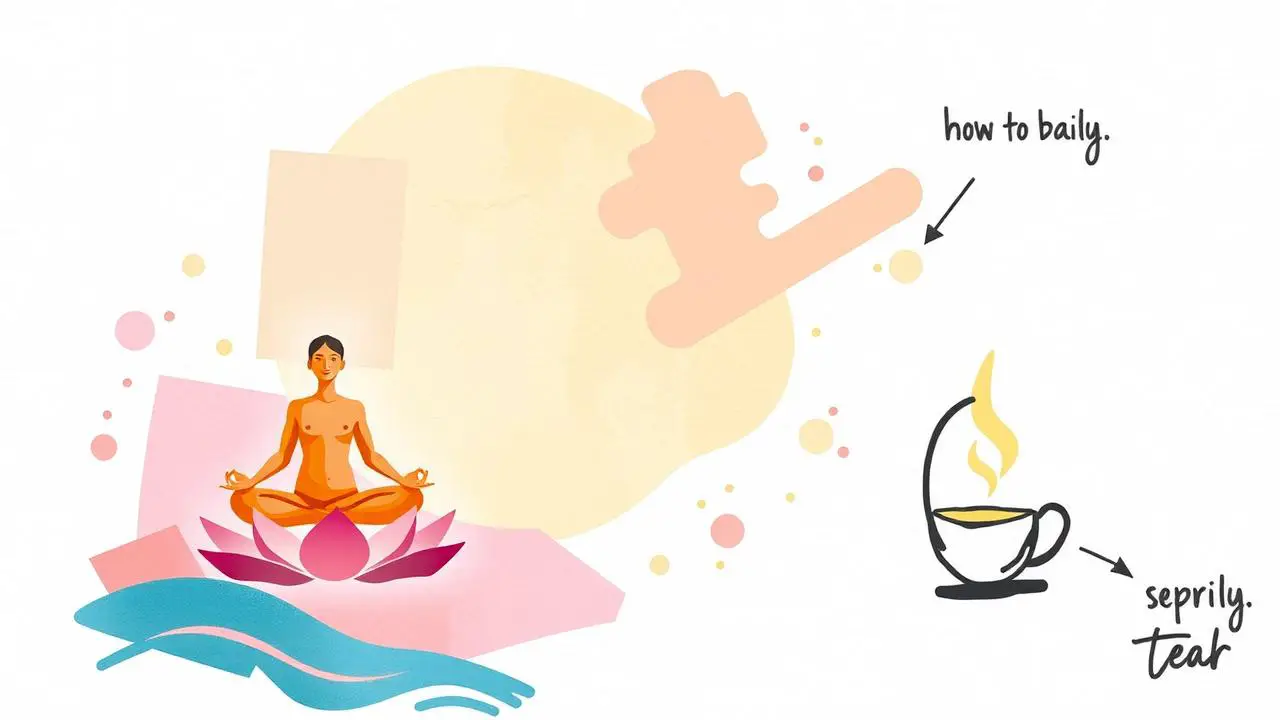Do you ever feel like you’re drowning in a sea of stress? Sometimes it can feel like the world is crashing down on you, and you’re barely treading water. But just like a skilled sailor, you can learn to navigate through the waves of stress and come out on the other side stronger and more resilient.
In today’s fast-paced world, stress is an inevitable part of life. Whether it’s work, relationships, or simply the daily grind, we all experience stress in one form or another. But it’s how we handle that stress that truly defines us.
To reduce stress in a stressful environment, you can try the following techniques:
- Practice deep breathing exercises
- Take short breaks throughout the day to stretch and move your body
- Practice mindfulness or meditation
- Prioritize tasks and manage your time effectively
- Talk to a trusted friend or colleague for support
- Practice positive self-talk and focus on the present moment
- Make time for self-care activities such as exercise, hobbies or reading.
Learning how to manage stress effectively can not only improve your mental and physical health, but it can also help you achieve your goals and live a more fulfilling life. So, let’s dive into some practical strategies for handling stressful environments and take control of our lives.
Understand Your Triggers
Understanding what sets you off is key to navigating high-pressure situations. In order to handle stress effectively, you need to identify coping mechanisms that work for you.
Take some time to reflect on your past experiences and recognize patterns of behavior. What triggers your stress? Is it a certain person, a specific task, or even just the thought of a looming deadline?
Once you’ve identified your triggers, you can start to develop strategies to manage them. It’s important to remember that everyone experiences stress differently. What works for one person may not work for another. So be patient and experiment with different techniques until you find what works for you.
Some people find that exercise or meditation helps to reduce their stress levels, while others prefer to talk to a friend or engage in a creative activity like painting or writing. Whatever works for you, make sure you incorporate it into your routine.
Recognizing patterns of behavior is also key to handling stress. Do you tend to procrastinate when faced with a deadline? Do you avoid certain tasks or situations that make you uncomfortable? These patterns can be hard to break, but with practice and awareness, you can learn to manage them.
By understanding your triggers and patterns of behavior, you can develop a more mindful approach to stress management that will serve you well in any high-pressure situation. So take some time to reflect on your experiences and develop a plan that works for you.

Practice Mindfulness and Meditation
Take a deep breath and let your thoughts drift away as you immerse yourself in the peaceful serenity of meditation and mindfulness. When you find yourself in a stressful environment, it can be challenging to stay focused and calm. However, practicing mindfulness and meditation can help you stay grounded and centered.
Mindful breathing is a simple technique that can be done anywhere, at any time. Taking a few deep breaths and focusing on your breath can help you find your inner peace and quiet your mind. This practice can bring about a sense of calm and help you manage your stress and anxiety.
Guided meditation is another technique that can help you stay focused and centered. This practice involves following a meditation instructor’s voice, who will guide you through a series of steps to calm your mind and body. Guided meditation can be done in person or through a mobile app. It’s an effective technique for reducing stress and improving overall well-being. Many people find that practicing guided meditation regularly helps them feel more relaxed and centered, even in the midst of a stressful environment.
Incorporating mindfulness and meditation into your daily routine can have significant benefits for your mental and physical health. It’s a simple yet effective way to manage your stress levels and improve your overall well-being.
So, the next time you find yourself in a stressful situation, take a deep breath, center yourself, and try practicing mindful breathing or guided meditation. These techniques can help you find your inner peace and empower you to navigate through challenging situations with ease.
As you focus on your inner peace, consider incorporating exercise and physical activity into your routine. These activities can also have a positive impact on your stress levels and overall well-being.

Exercise and Physical Activity
Get moving and feel better! Exercise and physical activity can have a powerful impact on your mental and physical health, helping you to feel more energized and alive.
Not only does exercise help to reduce stress and anxiety, but it also releases endorphins that can boost your mood and sense of well-being. Cardiovascular benefits such as improved heart health and increased blood flow to the brain can also enhance cognitive function, allowing you to think more clearly and effectively.
Group fitness can be a great way to incorporate exercise into your routine while also providing social support and accountability. Joining a fitness class or sports team can help to alleviate feelings of isolation and provide a sense of community. Additionally, exercising in a group setting can be a fun and motivating way to stay active and challenge yourself.
Prioritizing physical activity as a form of self-care is essential for maintaining a healthy mind and body. By incorporating exercise into your daily routine, you can reduce stress, improve your mood, and increase your overall sense of well-being.
So get moving and prioritize your health today!

Prioritize Self-Care
You may already know that self-care is important, but have you considered how it can impact your ability to handle stress? Prioritize healthy eating habits, adequate sleep, and relaxation techniques to greatly improve your overall well-being and help you cope with stressful situations more effectively.
By taking care of your body and mind, you can build resilience and better manage stress in your daily life. So why not start implementing some self-care practices today and see the positive impact it can have on your stress levels?
Healthy Eating Habits
Eating nutritious foods not only nourishes your body, but also fuels your mind and emotions, helping you stay centered and focused in challenging situations. When you’re in a stressful environment, it can be tempting to grab fast food or sugary snacks for a quick energy boost. However, these foods only provide a temporary solution, leaving you feeling sluggish and even more stressed in the long run. Instead, try incorporating these healthy eating habits into your routine:
- Cook meals at home: Cooking your own meals allows you to control the ingredients and portion sizes, ensuring that you’re fueling your body with wholesome foods.
- Plan your meals ahead of time: Meal planning can help you stay on track with your healthy eating habits, and also saves you time and money in the long run.
- Incorporate a variety of fruits and vegetables: Eating a rainbow of fruits and vegetables provides your body with essential vitamins and nutrients.
- Stay hydrated: Drinking plenty of water throughout the day can help you stay alert and focused, and also helps flush out toxins from your body.
By practicing these healthy eating habits, you’ll be better equipped to handle the stress of a challenging environment. However, it’s important to remember that a healthy diet is only one piece of the puzzle. Adequate sleep is also crucial for managing stress, which we’ll discuss in the next section.
Adequate Sleep
Maintaining sufficient sleep is imperative for effectively managing stress, which we’ll delve into in this section. Sleep hygiene is crucial for achieving restful sleep, and it involves establishing a consistent sleep schedule, avoiding caffeine and alcohol before bedtime, and creating a comfortable sleep environment. Practicing good sleep habits can help you fall asleep faster, sleep deeper, and wake up feeling more refreshed.
On the other hand, sleep deprivation consequences can be detrimental to your physical and mental health. Sleep deprivation can cause irritability, mood swings, memory problems, and a weakened immune system. It can also increase your risk of developing chronic conditions like obesity, diabetes, and heart disease.
Therefore, prioritizing sleep as a means of stress management is essential for your overall well-being. Now, let’s explore some relaxation techniques to complement your sleep hygiene routine and maximize stress reduction.
Relaxation Techniques
Let’s discover some effective relaxation techniques that can help you overcome stress and improve your well-being.
One of the most effective techniques is deep breathing. When you’re feeling stressed, take a moment to focus on your breath, and take slow, deep breaths in and out. This technique can help calm your mind and reduce your stress levels.
Another effective relaxation technique is progressive muscle relaxation. This involves tensing and relaxing different muscle groups in your body, one at a time. By doing this, you can become more aware of the tension in your body and learn to release it. With regular practice, progressive muscle relaxation can help you relax more deeply and reduce your overall stress levels.
By incorporating these relaxation techniques into your daily routine, you can learn to manage stress more effectively and improve your overall well-being.
Effective communication is another important aspect of managing stress, and we’ll explore that in the next section.

Effective Communication
You’ll need to speak clearly and confidently like a captain maneuvering a ship through rough waters if you want to navigate the choppy seas of a stressful environment and communicate effectively with your team. Effective communication is crucial for managing stress in any situation, but it becomes even more important when you’re dealing with a high-pressure environment.
Active listening and nonverbal communication are essential components of effective communication. You need to pay attention to what others are saying and how they’re saying it, and respond appropriately. This requires you to be fully present in the moment and to be able to read the room and adjust your communication style accordingly.
One key to effective communication in a stressful environment is to stay calm and composed, even when things are chaotic around you. This can be easier said than done, but it’s essential if you want to be an effective communicator. Take a deep breath and focus on what you need to say, rather than getting caught up in the stress of the moment. Use language that’s clear and concise and avoid getting bogged down in details or unnecessary information.
Remember that effective communication is a two-way street. It’s not just about what you say, but also how you listen. Active listening is a critical component of effective communication, especially in a stressful environment. Make eye contact with the person you’re talking to, and pay attention to their body language and tone of voice. This will help you understand their perspective and respond appropriately.
By mastering effective communication, you can navigate the choppy waters of a stressful environment and achieve your goals with your team.
When it comes to managing stress, effective communication is just one piece of the puzzle. The next step is to master the art of time management. By learning how to prioritize your tasks and stay organized, you can reduce stress and achieve your goals more efficiently. With the right tools and techniques, you can overcome any obstacle and succeed in even the most challenging environments.

Time Management
To achieve success in high-pressure situations, it’s essential to master the art of time management and prioritize tasks efficiently. The Pomodoro Technique is a widely used time management method that involves breaking down work into intervals, typically 25 minutes, with short breaks in between. This technique can help you focus on one task at a time and achieve greater productivity.
Task prioritization is also crucial in stressful environments. By identifying the most critical tasks and tackling them first, you can reduce the overall workload and avoid feeling overwhelmed.
To effectively prioritize tasks, you should start by creating a to-do list. Write down all the tasks that need to be completed and assign them a priority level. Next, break down larger tasks into smaller, manageable chunks. This will make it easier to focus on one task at a time and avoid feeling overwhelmed.
When prioritizing tasks, it’s important to consider deadlines and the level of impact each task will have on your overall goals.
Here are four tips for effective time management and task prioritization in high-pressure environments:
- Use the Pomodoro Technique to break down work into intervals with short breaks in between.
- Create a to-do list and assign priority levels to each task.
- Break down larger tasks into smaller, manageable chunks.
- Consider deadlines and the level of impact each task will have on your overall goals when prioritizing tasks.
To be successful in high-pressure environments, it’s crucial to master the art of time management and task prioritization. By using techniques like the Pomodoro Technique and creating a to-do list, you can increase productivity and reduce stress. However, if you find yourself still struggling, don’t hesitate to seek support from colleagues or a mentor. Remember, it’s okay to ask for help when you need it.

Seek Support
Navigating high-pressure situations can feel like swimming against a strong current, but seeking support from colleagues or a mentor can act as a lifeboat to keep you afloat. When you’re feeling overwhelmed, it’s important to remember that you don’t have to face it alone.
Whether it’s discussing your workload or seeking advice on how to manage stress, having a support system can make all the difference. One aspect of seeking support is setting healthy boundaries. It’s important to establish clear guidelines for yourself and others around what you can and cannot handle.
This means saying no to extra work when you’re already feeling overloaded, and setting aside time for self-care to prevent burnout. By prioritizing your own well-being, you’ll be better equipped to handle stressful situations when they arise. If you find that your stress levels are impacting your ability to function, it may be time to seek professional help.
There’s no shame in reaching out to a therapist or counselor for support. These professionals can provide the tools and resources you need to manage stress and improve your mental health. Remember, seeking help is a sign of strength, not weakness.

Practice Gratitude and Positive Thinking
Feeling grateful and focusing on positivity can help improve your mental state during challenging times. When everything seems to be going wrong, it can be easy to get caught up in negative thoughts and emotions. However, taking a moment to reflect on the things that you’re thankful for can shift your mindset and help you see the situation in a more positive light.
One way to practice gratitude is by keeping a gratitude journal. At the end of each day, write down three things that you’re grateful for. This exercise can help you focus on the good things in your life, even when everything else seems to be falling apart.
Another way to cultivate positivity is by practicing positive affirmations. These are statements that you repeat to yourself to reinforce positive beliefs about yourself and your abilities. For example, you might say, “I’m capable of handling any challenge that comes my way” or “I’m strong and resilient.” By repeating these affirmations regularly, you can train your brain to focus on the positive aspects of your life and build your confidence in your ability to handle stress.
Gratitude journaling and positive affirmations are simple practices that can have a big impact on your mental state during stressful times. By focusing on the good things in your life and reinforcing positive beliefs about yourself, you can build resilience and improve your ability to handle challenges. As you begin to incorporate these practices into your daily routine, remember to be patient with yourself. It takes time and effort to change your mindset, but with consistent practice, you can cultivate a more positive outlook on life and navigate stressful environments with greater ease.
As you continue to work on practicing gratitude and positive thinking, it’s important to set realistic expectations for yourself. While these practices can be powerful tools for managing stress, they’re not a magic solution that will instantly make all your problems go away. In the next section, we’ll discuss some strategies for setting realistic expectations and managing your stress in a healthy way.

Set Realistic Expectations
Don’t let unrealistic expectations add to your stress. Take a moment to assess your goals and adjust them accordingly to achieve a healthy balance in your life. It’s important to identify boundaries and manage your workload effectively to avoid feeling overwhelmed.
Setting realistic expectations can help you avoid burnout and maintain a positive outlook in stressful environments. To set realistic expectations, start by assessing your workload and identifying your priorities. Make a list of tasks that need to be completed and then prioritize them based on their importance and urgency. Once you have a clear understanding of your workload, set achievable goals for yourself. Remember that it’s okay to ask for help or delegate tasks if necessary.
Another way to manage your workload and set realistic expectations is to learn to say no. It’s easy to get caught up in trying to please everyone, but saying yes to everything can lead to feeling overworked and stressed. Be honest with yourself and others about what you can realistically handle. Saying no can actually be liberating and allow you to focus on what’s truly important.
By setting realistic expectations, identifying boundaries, and managing your workload effectively, you can avoid feeling overwhelmed in stressful environments. Remember that it’s okay to adjust your goals and ask for help when needed.
In the next section, we’ll discuss how to monitor your progress and make adjustments along the way.

Monitor Your Progress
Keep an eye on how you’re doing and make adjustments as needed to stay on track. This is especially important when you’re in a stressful environment. Tracking your progress can help you stay motivated and measure your success. By monitoring your progress, you can identify areas where you need to improve and make changes to your approach or strategies.
One way to track your progress is to set specific goals and measure your progress towards them. This can be done by creating a table with two columns and four rows. In the first column, list your goals. In the second column, write down your progress towards each goal. This will help you see how far you’ve come and what you still need to work on. By setting smaller, achievable goals, you can stay motivated and build momentum towards your larger objectives.
Another way to monitor your progress is to keep a journal or log of your accomplishments and challenges. This can help you reflect on your experiences and identify areas where you’ve made progress or faced obstacles. By writing down your thoughts and feelings, you can gain insight into your own motivations and strategies. This can help you make adjustments and stay focused on your goals, even in the face of stress and adversity. Remember, tracking your progress is an ongoing process. It’s important to stay flexible and open to new approaches as you work towards your goals.

How Can I Apply Stress Management Techniques in a Workplace Setting?
In a thriving in stressful workplace, applying stress management techniques is crucial. Practice mindfulness, time management, and efficient communication. Take regular breaks, set boundaries, and prioritize tasks. Seek support from colleagues and managers. By implementing these strategies, you can navigate a stressful workplace more effectively.
Conclusion
Congratulations on taking the first step towards managing stress in your life. Learning how to handle stressful environments is a constant journey that requires patience and effort.
It’s like tending to a garden, where you must cultivate the soil, plant the seeds and water them regularly to ensure that your flowers grow tall and strong. In the same way, managing stress requires constant attention and care.
Remember that managing stress is not a one-size-fits-all solution, and what works for someone else may not work for you. It’s essential to understand your triggers, practice mindfulness, exercise, prioritize self-care, and seek support. By taking these steps, you can create a positive environment for yourself and develop resilience in the face of stress.
In conclusion, managing stress is an ongoing process that requires dedication and effort. However, with the right tools and mindset, you can overcome any obstacle. Like a skilled gardener, you must be patient and persistent, and with time, you’ll see the fruits of your labor bloom into a beautiful and tranquil garden.
Keep in mind that you’re not alone in this journey, and there’s always support available to help you along the way.




